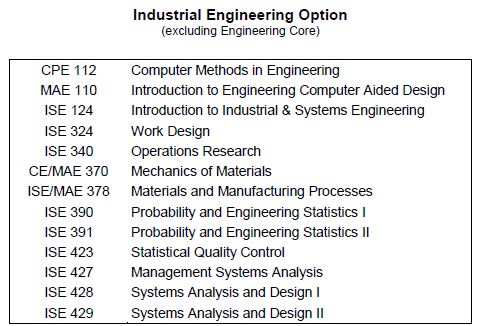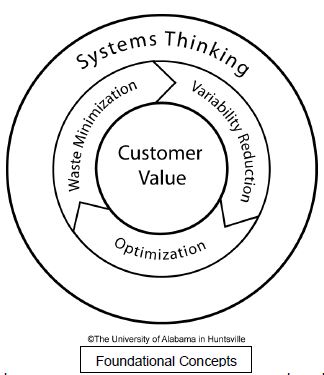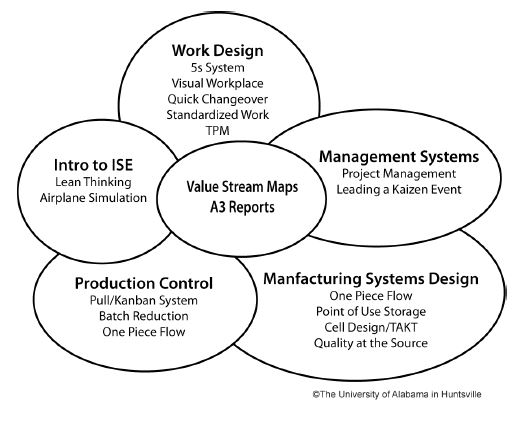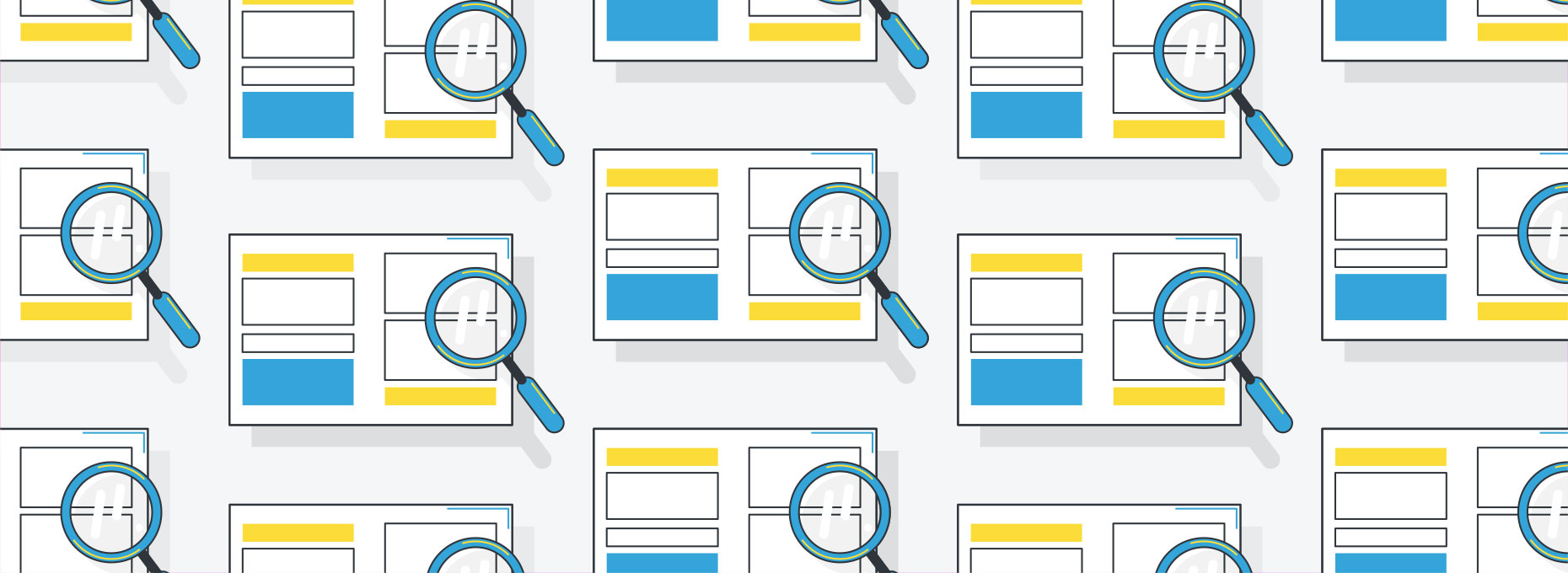Lean Inroads into Alabama Academia
UAH integrates lean throughout its industrial engineering curriculum
By George Taninecz
At the University of Alabama in Huntsville (UAH), faculty of the Industrial Systems and Engineering and Engineering Management (ISEEM) department understand that many businesses have embraced lean manufacturing or at least have an awareness of lean and similar improvement tools. More importantly, the ISEEM faculty recognize that their graduates should have knowledge of and experience with these concepts when they enter the marketplace, and they’re making sure that happens.
Although the connection between the needs of business and the lean capabilities of graduates seems imperative, many colleges and universities have failed to link the two for myriad reasons — accreditation procedures, staff not versed in or wanting to teach lean, and/or simply the bureaucracies of higher education. That’s not the case at UAH, a research-intensive university in the heart of Alabama’s aerospace industry with more than 7,100 students; about half of UAH graduates earn a degree in engineering or science. ISEEM faculty have approached their curriculum from a different perspective, one that recognizes lean and other modern improvement tools as inherent to industrial engineering and, thus, fundamental concepts that should be integrated throughout the undergraduate curriculum (see Industrial Engineering Option curriculum list).


Lean and modern improvement methods help to define what it means to be an industrial engineer, says Phil Farrington, ISEEM associate professor and director of distance learning. “Our biggest problem is articulating to people what industrial engineering is, and lean and six sigma give us, we think, a mechanism to more clearly articulate what industrial engineers do and help us engage our students.
“I think it’s important for our discipline to understand the connections to lean. Lean is really the evolution of some fundamental concepts that started when our discipline started,” adds Farrington. “I think it’s important for our students to understand that and think through the connections between IE and lean and IE and six sigma. A lot of what we teach is connected to those two modern ideas, but those modern ideas are grounded in fundamental concepts we’ve been teaching for 50 or 60 years.”
The integration of lean and six sigma at UAH began in 2000 under Bernard Schoer, at that time both a professor within ISEEM and director of the Alabama Technology Network (ATN), one of 13 not-for-profit Manufacturing Extension Partnership centers (MEPs) within Alabama and of one of about 350 nationwide. “He brought lean ideas into the curriculum and said, „They need to know about it,’” says Farrington. “The rest of us have basically continued on with his tradition because we liked what we saw.”
That continuation reached a milestone in 2005 when the ISEEM department chairman and several of the faculty began attending a lean-certificate program offered by ATN, and then in February 2006 they agreed to integrate lean concepts throughout the curriculum. At the urging of department chairman, Jim Swain, faculty rewrote their mission statement to reflect the integration of lean and six sigma, but did so without using those terms; the new mission statement was enthusiastically supported by the entire ISEEM faculty. “Our concern was that
titles may change but the fundamental concepts shouldn’t,” says Farrington.
The UAH statement instead addresses waste minimization and variability reduction (concepts that are easy to equate with lean and six sigma) and system optimization (e.g., operations research, mathematical techniques, and simulations). “To do those you need to think about the system in a holistic manner and you need to get the right people together collaborating, with the ultimate focus being customer value,” says Farrington. “Our objective is to help our students understand that those are foundational concepts, understand the tools that allow you to do those, and that it’s an IE’s job.” (See diagram below.)

Dawn Utley, an ISEEM associate professor, attended the ATN lean training. She teaches the entry-level course Introduction to Industrial and Systems Engineering, which introduces basic fundamental concepts of industrial engineering. After going through the lean program, Utley rearranged the course, integrating lean principles and simulations as appropriate industrial engineering topics occur. For instance, when teaching work design, 5S in the workplace is addressed. Other lean concepts include value-stream mapping, preventive maintenance, and A3 reports (to be increasingly used by students as they progress through the ISEEM program). In addition, required reading includes Lean Thinking by James Womack and Daniel Jones (Simon & Schuster, 1996).
“I tried to break up the principles and put them where they would typically be housed among industrial engineering topics,” Utley says. “Then I took the airplane simulation [developed by the Lean Aerospace Initiative for demonstrating the value and challenges of implementing lean principles] and spread it out throughout the whole semester, and that was a huge success. The students really enjoyed learning about topics, coming in for the simulation the next class meeting, and running through this and having an opportunity to actually apply what they learned. And they made the classic mistakes, and I just let them. … We allowed them the safe environment of failure, but learning from those mistakes.
“The lean concepts are really integral to what we teach in industrial engineering,” adds Utley. “We don’t want to ride the fad wave of lean and six sigma and expire at the end of the fad. We want to integrate these into industrial engineering fundamental topics and allow the students to connect the pieces as we go. We didn’t want to teach just a lean class.” (See diagram illustrating how several lean techniques are deployed throughout the ISEEM curriculum.)
Lean Concepts throughout ISEEM Curriculum

Alisha Youngblood, ISEEM assistant professor, also went through the ATN training, and remembers, “This is just good-old-fashioned IE, but packaged in a way that non-IEs can understand it. I had been incorporating the principles of lean into my courses before then, I just didn’t really know it. I wasn’t presenting it in the traditional lean format.” Youngblood teaches Work Design, a methods and standards course that looks at how you design a job, and Production and Inventory Control.
She says the integration of lean has helped students to see how all the ISEEM courses are interconnected and their overall role as an industrial engineer. But like others at UAH, she tries not to overemphasize the “lean” term. “I don’t want such a focus on lean that should that terminology go away the students think the concepts have gone away.” Youngblood says familiarity with the term does offer students an edge in the workplace, “but I want them to realize that a lot of these concepts have been around but tended to be included in this small, secret society of industrial engineers. Finally, as IEs, we’re getting the word out in such a way that lots of people can do lots of jobs better.”
“Part of the effort that’s gone on in the industrial engineering department has taken lean back to its roots. The industrial engineering department has said, „This is the stuff we’ve been teaching for a long time, we just haven’t had a context by which to put it all together in one package,’” says Greg Harris, current director of the ATN. Harris conducted the first lean lectures for ISEEM in 2000, covering lean manufacturing principles and value-stream mapping. In 2001, lectures on additional tools such as quick changeover/SMED, cellular manufacturing, and pull/kanban were added.
Unlike a single lean class or elective, says Harris, an integrated ISEEM program emphasizes to students that lean is more than an option. “What we’re trying to teach the industrial engineering students — and now in the business school — is that it’s not a choice. These are good tools to use; we ought to be applying them. What’s the difference between teaching an industrial engineer EOQ [economic order quantity] and teaching setup reduction? If you’re just applying EOQ without the setup part of it, you’re never going to make improvement. EOQ is not bad; it’s bad if you don’t improve.”
In addition to lean principles, ISEEM also specifically integrates six sigma methods, and students can earn a green-belt certification. Sampson Gholston, associate professor, teaches courses with six sigma content at the undergraduate level (Statistical Quality Control) and graduate level, as well as quality control seminars for ATN. Maruf Rahman, ATN director of process improvement initiatives and a certified black-belt administer, conducts the green- and black-belt certification exams.
Gholston says his courses have been modified to address lean and six sigma and, in making that change, some traditional IE concepts have been compressed. Some 30 students have earned green belts over the last three years, but, more importantly, says Gholston, students leave with IE degrees and green belts. He, too, encourages students to not get caught up in the terms but “to use your engineering judgment. To us, this is IE, not lean or anything else. The common theme is the IE tools. … If you don’t agree with lean being lean, at least look at the principles of how it can make you a better engineer.”
Collaboration with ATN
The integration of lean and six sigma within UAH ISEEM has occurred in part because of three factors coming together, says Farrington:
- Faculty openness: “We’ve got a faculty that is willing to try things and agrees that this is what industrial engineers should do.”
- A champion: Integration, especially at the pace underway at UAH, required the motivation of all persons involved, and that meant someone pushing the group. Farrington says it could have been anybody leading the charge — not just him — but someone has to push it.
- ATN time and materials: “If the faculty had to create it and figure out how to integrate it, it would be much more difficult and much slower. We wouldn’t be moving at the pace we’re moving.”
ATN was established at UAH in 1996 and offers consulting and continuous-improvement tools and systems to companies and organizations in the region. Its base of expertise has grown to encompass lean, six sigma, ISO, and “the basic, different ways that industry attempts to insert continuous improvement in their programs,” says Harris. Most ATN consulting and training material has evolved from MEP content, for which ATN was a source provider. ATN also is the only Lean Aerospace Initiative (LAI) EdNet center outside of the Massachusetts Institute of Technology, which gives it “vast amounts” of additional resources. ATN looks to align its materials with consistent methods and descriptions of lean, specifically those based on the Toyota Production System and promoted by the Lean Enterprise Institute.
As an MEP center, ATN receives funds from the Department of Commerce, matching funds of approximately 2-to-1 from Alabama, and in-kind services and facilities from UAH. Those dollars, though, cover less than 30% of the ATN budget of approximately $1.4 million, says Harris. So, since its inception, ATN has performed fee-generation consulting using a staff of experts, enabling it to withstand the periodic political and budgetary fallouts that can hit MEPs.
Since the state and university support the ATN, Harris willingly allocates revenue-producing time of ATN experts to teaching and working with UAH faculty and students. “We take this time that we would usually be out working with companies and apply it to building new resources and a new workforce for industry. And hopefully some of those [students] will stay here in the state and contribute to the continuing growth of Alabama industry. That’s the altruistic motive behind what we’re doing. The ATN tries to take the position that we’re here to try to help companies become more competitive, and there are multiple ways to do that. One is providing training to help develop solutions to problems they currently have. One is to help develop the workforce they need to continue to be competitive in the future. We are a part of an educational institution, and we take that very seriously.”
A core component of ATN’s industry mission and its collaboration with ISEEM began in 2001 with the advent of the lean certificate training series. “We give [attendees] the tools to actually start implementing lean in their factories,” says Harris. ATN typically puts on four to five week-long, open-enrollment sessions per year for industrial attendees as well as four sessions per year for specific companies. It annually awards about 200 certificates within industry. Starting in2002, ISEEM students were required to participate in the certificate series, and, like business attendees who successfully complete the program, they also receive a certificate.
Eventually the requirement that ISEEM students participate fully in the certificate series will be phased out because the content will be covered throughout the ISEEM curriculum, says Farrington. Students will instead work through a simulation of problems to prove lean capabilities and receive the ATN certificate once those skills are exhibited. Getting the certificate is important, adds Farrington, because just like a green- or black-belt offered through six sigma courses, it gives students more than a degree.
“Our students have the ability to walk out with a bachelor’s, a lean certificate, and at least a green belt, and that gives them a competitive advantage in the job market,” says Farrington. “The bachelor’s is a necessary condition to get a job, but a lean certificate and a green belt sets them apart from most other students.”
Hands-On Improvement Projects
The lean education of UAH ISEEM students is further honed through projects out in industry. Students in the senior design course are required to participate on a company project, applying the concepts and tools they’ve learned in the classroom. It’s “taking the student out of the educational arena and putting them into the work arena,” says Harris, “and they have a year to try and make that transition. As my [staff] are out working with clients, we identify projects that companies need to have done, but they’re maybe not on the „critical path’ of their continuous-improvement program. That means that a student taking a two-semester view of it can spend time doing it. The things my guys work on are immediate need: „We’re going out of business if we don’t fix it.’”
“Greg has identified companies they work with that can use some assistance. They’d like to do a project but they either don’t have engineering personnel or resources or their engineering personnel are overtaxed. And so they need somebody to look at it and propose ideas,” says Farrington. “Greg will recommend companies, and we’ll talk to them, and agree to do a senior design project. Or the companies will contact us. This year we’ve had a little of both.”
Harris works with Farrington to coordinate the student teams and projects. Each student member has team responsibilities, and the team is ultimately responsible for their particular project (with oversight by ATN). Under Farrington’s leadership the program has been taken to a new level, notes Harris, with student teams taking on a consulting mindset. They must provide project updates, dress like a team at the client site, and exhibit a professional presence on location.
Students recognize the importance of decisions they make out in the business sector and the commitment required, says Harris. “One of the things I tell students is that these [companies] are putting their well-being in your hands when you’re out here changing their operations. You can’t go in there and say, „I think this will work.’ You have to be pretty sure that what you’re doing is the right thing to do. Their livelihood depends on this.” He says ATN has never had a problem with the commitment or desire of teams to do well, but will occasionally step in when students don’t have the tools to accomplish what they need to do. For example, students are not equipped or have the time to go in and train a large group of employees, so if that’s needed ATN staff willjoin them on the project.
The student projects are currently a free service for companies, although some travel expenses may be covered. The National Institute of Science and Technology, which oversees the MEPs, will survey the host company to determine the impact of a student project on a company’s operations: one project saved hundreds of thousands of dollars for the client. ATN and UAH are considering ways for benefited companies to support the program. For example, they may request donations after projects are completed, with donations to be earmarked for the industrial engineering program.
“Why wasn’t I taught this? Why did I spend four years of my life being trained about how they used to do things?”
Two recent ISEEM graduates are currently on the ATN staff, and have witnessed the growth of lean within ISE and the need for lean in industry. Heather Shar is a research associate whose primary role has been specializing in value-stream mapping, kaizen facilitation, and lean in the office. She says, “In companies that we work with that are adopting lean, the engineers are either coming to us for training because they have to have it because their job says so, or they’re coming to us for facilitation and they’ve had training from another entity. Very few people that I run into in industry got this type of education as part of their engineering class.”
Nicholas Loyd is a lean manufacturing specialist and 2000 graduate from UAH who received most of his lean experiences post-UAH (he was a member of the class that heard the first lean lectures in ISEEM). He admits to being frustrated that he didn’t get enough lean in college: “Why wasn’t I taught this? Why did I spend four years of my life being trained about how they used to do things?” Now he helps ensure other students don’t have the same frustration by instructing lean in the certificate series and conducting lectures in ISEEM undergraduate courses and the business school (lean in service and master’s level operations management). Loyd says that instead of saving one plant at a time, he’s teaching 30 students who can save 30 plants.
Future State at UAH
Through his work with LAI EdNet and the Lean Education Academic Network (educators dedicated to implementing lean in academia), Harris says he’s in contact with about 100 universities that are trying to bring lean into their classes. “As far as I can tell, we are the only school teaching lean concepts in our engineering school and our business school at the same time. At most places, it’s either one or the other.” In addition to ISEEM, the business school at UAH began pulling in lean content this year, starting with a few selected lectures provided by ATN staff.
But despite this pace-setting progress, both Harris and Farrington are plotting the next steps. For example, Farrington cites the achievements of Cardiff University, Wales, which offers a lean master’s level module within the Cardiff Business School. UAH ISEEM department is beginning to work lean and six sigma into its master’s level courses covering manufacturing system design and quality control, and Farrington hopes to develop cross-listed courses with the businessschool that might evolve into a lean master’s degree.
Farrington says there are typically four stages of lean implementation within colleges and universities: interject modules; add specific lean courses; integrate lean across the curriculum; and transformation of the curriculum.
“Transformation is looking at and parsing the curriculum in a different way so that we create new courses,” says Farrington. “What do we really need to be teaching them? Is there an innovative way or a different way of parsing out the material such that we create a more powerful model for them and a better understanding of things? My thinking over the last year and half has been that what we’re doing is good, and it’s gone beyond what I see as the first step, but at some point we need to back up and ask, „What does it really need to look like? How do these pieces need to fit? Are the names right? Are the concepts we’re teaching in here correct. Are there other concepts and ways we can package these things that are more effective?’ That’s what transformation means to me.”
And those are likely to be the questions that Farrington, Harris, and the UAH faculty grapple with in the coming years.
For more information:
- University of Alabama in Huntsville, Industrial Systems and Engineering department, Phillip A. Farrington, Ph.D., Associate Professor, (256) 824-6568 or paf@ise.uah.edu
- The Alabama Technology Network, Greg Harris, director: (256) 824-6060 or harrisg@email.uah.edu
- The Lean Enterprise Institute at https://www.lean.org is a nonprofit research, education, publishing, and conference company with a mission to advance lean thinking around the world. We teach courses, hold management seminars, write and publish books and workbooks, and organize public and private conferences.





